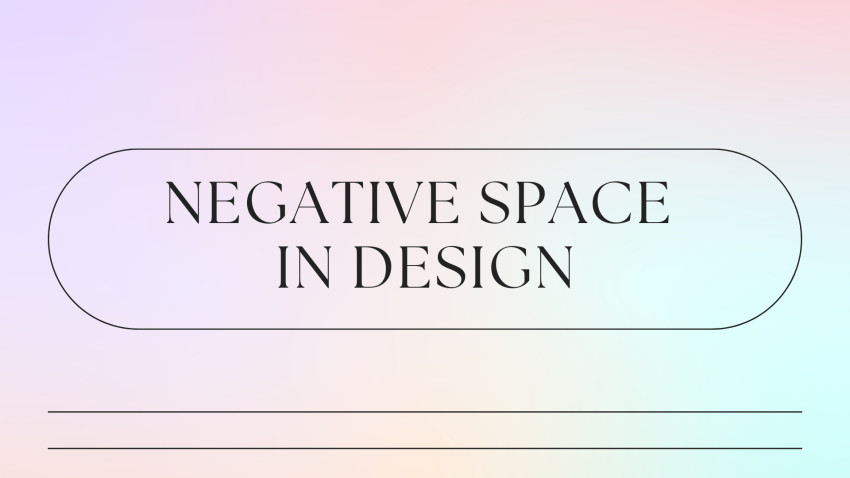
Design is a language, and what it conveys relies heavily on the way space is managed within it. In the world of art and design, space plays a vital role. It encompasses the area around objects and the gaps between subjects. As a designer, you're probably familiar with the terms "negative space" and "white space," both of which are essential in various design fields, including graphic design, web design, UI/UX design, and photography.
This article aims to shed light on the significance of negative, white, and positive space in design, providing detailed explanations of each and highlighting their differences and importance.
Understanding the Role of Space in Design
Space in design encompasses measurements of height, width, and depth within which elements exist and interact. In design, space is everything. A well-balanced, visually pleasing design effectively utilizes space. When you come across a design that feels off, chances are the space wasn't managed correctly.
Properly understanding negative and positive space in design helps draw users' attention to essential interface elements. There's a difference between having empty space in design and strategically employing space to ensure balance and effective communication with the user.
Small vs. Large Spaces in Design
In digital design, space can be categorized into two types based on area size:
Smaller Spaces:
Surrounding design elements such as buttons, icons, fonts, line spacing, lists, and paragraphs.
Negative space in typography aids readability and enhances overall layout clarity.
Adequate negative space between letters, lines, and other UI elements is essential for a smooth user experience.
Larger Spaces:
Refers to the overall layout and design of a web page or app.
Consider the application of negative space to separate UI elements.
Determine text alignment, padding, and margins for each element.
Carefully manage space to retain the user's visual flow and attention.
Effective use of space ensures user engagement and navigation in the limited attention span of digital design.
What Is Negative Space?
Negative space in design refers to the area around and between the subjects in a composition. It creates an illusion and communicates a message to the audience. Negative space is not limited to white space; it includes space between texts, paragraphs (micro negative space), and larger elements like headers and footers (macro negative space).
What Is White Space?
White space in design originated from print media, where most work was done on a white background. White space refers to the area around objects or focal points and allows them to stand out. In digital design, white space provides breathing room for positive elements. It can be any color or texture and serves to emphasize the subject matter.
What Is Positive Space?
Positive space refers to the area of interest or subject in a design. It includes elements in the foreground, such as icons, buttons, and content. Positive space is dynamic, motivating, and active, completing the design when combined with negative space.
Importance of Negative Space in Design
Negative space enhances compositional balance, giving meaning to the design and making it visually appealing. It draws attention to focal points, improves usability, and cushions important content, making it more readable and attractive. Negative space is crucial for crafting a seamless user experience in digital products, making the design accessible and elegant.
Importance of White Space in Design
White space ensures readability and distinguishes elements, guiding users through the design. It creates a clutter-free, clean, and minimalist aesthetic, emphasizing every element in space design and enhancing the overall look of the website.
Types of Negative Space in Design
Negative space can be categorized into active vs. passive and micro vs. macro. Active space leads the user through the design with asymmetrical placement, while passive space offers balance with symmetrical placement. Micro negative space exists between elements, improving legibility, while macro negative space surrounds larger UI elements, holding the design together.
Core Factors Influenced by Negative Space
Brand Communication: Negative space sets the tone for your brand and communicates its personality.
User's Attention Ratio: It highlights key UI elements and increases user attention.
Readability: Proper spacing between lines and letters enhances text readability.
Nature of the Resource: Negative space affects the sense of authenticity and reliability of your digital product.
Negative Space vs. Positive Space: Differences
Negative and positive space complement each other; one cannot exist without the other. Positive space is the area of focus, while negative space is the background and surrounding area. They work together to create meaning in a design.
White Space vs. Negative Space: Differences
White space and negative space are sometimes used interchangeably, but they have distinct roles. White space surrounds elements and allows them to breathe, while negative space is the space close to and around positive space, creating balanced compositions for seamless user experiences.
Challenges in Using Space in Design
Balancing positive and negative space can be challenging, as can effectively conveying your message. Overusing or underusing space can lead to user distraction or misinterpretation.
In conclusion, space in design is crucial for user engagement and effective communication. A harmonious blend of negative, white, and positive space creates designs that resonate with users and deliver clear messages, ultimately achieving design success.



